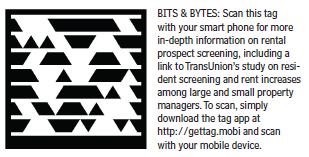Screen Holistically
While the connection between bad debt and lowered credit thresholds is an obvious one, less palpable is the link between lowered screening parameters and the ability to push rents. Sure, manipulating applicant screening parameters is a powerful—and often seductive—way for property managers to boost occupancy, but the importance of using screening technology in a more global effort to manage rents, revenues, vacancy, and bad debt risk across a property increasingly shouldn’t be ignored.
Screening Solutions
Forget credit scores. Here are three ways to get the most revenue—if not occupancy—out of your applicant screening technologies.
Be heavy-handed: Adjustments to screening parameters should be incremental, and close-ended. ?A lowered scoring parameter to gain quick occupancy can be effective but have a deleterious effect on property demographics if not readjusted quickly.
Get ancillary: Taking on increased risk should bring the promise of greater return. Implement systems and approval processes that generate higher security deposits—or, even better, higher rents—on applicants who are approved with conditions.
Focus on payment history: While not forgetting credit altogether, most screening pros are moving past it to rental payment history as a preferred screening metric. Consider approving applicants with poor credit who nonetheless have a stellar record of paying their rent on time.
“We’re very sensitive and tied in to pricing at individual properties and at individual unit levels and are constantly watching the supply and demand metrics and bad debt,” says Chris Jenkins, vice president of financial planning for Chicago-based Equity Residential, a REIT with 129,604 units under ownership. “We approach screening with a focus on how all the parameters are interacting [with each other], with the conscious idea that we may give up a little here and there but we’ll make enough on the revenue side that will more than cover what we may give up in a little bit of additional bad debt or vacancy. It’s more of a holistic view: We’re not trying to chase occupancy simply by reducing our acceptance levels on credit.”
According to a June 2011 study of 1,252 property managers conducted by Chicago-based credit bureau TransUnion, apartment firms that had more difficulty finding qualified renters (and ostensibly were using higher applicant approval thresholds) nonetheless were able to increase rental prices in 2010 compared with industry peers that were having less difficulty finding qualified renters.
The results—which also closely mirrored a dichotomy between large property managers overseeing 200-plus units and smaller property managers with 200 units or fewer—showed that 64 percent of operators that were more stringent on screening parameters were able to increase 2010 rents, compared with only 36 percent in the occupancy-first group.
